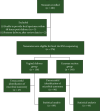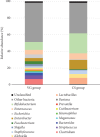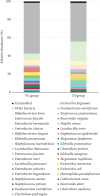Comparison of Gut Microbiomes Between Neonates Born by Cesarean Section and Vaginal Delivery: Prospective Observational Study
- PMID: 39640900
- PMCID: PMC11620805
- DOI: 10.1155/bmri/8302361
Comparison of Gut Microbiomes Between Neonates Born by Cesarean Section and Vaginal Delivery: Prospective Observational Study
Abstract
Background: Balanced diversity and abundance of gut microbiome play important roles in human health, including neonatal health. Though not established, there is evidence that the delivery route could alter the diversity of neonatal gut microbiomes. Objective: The objective of the study was to investigate the differences in the gut microbiomes of neonates delivered via cesarean section compared to those born by vaginal delivery and to identify the predominant microbial taxa present in each group. Study Design: A prospective observational study of 281 healthy neonates born between February 2021 and April 2023 at Her Royal Highness Maha Chakri Sirindhorn Medical Center, Srinakharinwirot University, Thailand, was performed. The study population was divided into two groups: 139 neonates born via vaginal delivery and 141 neonates born via cesarean section. The microbiota composition of each neonate's fecal sample was identified by using 16S ribosomal ribonucleic acid metagenomic sequencing. Results: Neonates delivered vaginally exhibited a gut microbiome with higher abundance and diversity than those delivered by cesarean delivery. Bifidobacterium was the dominant genus in both groups. Bifidobacterium breve was the dominant species and was significantly higher in cesarean-delivered neonates compared to those delivered vaginally (24.0% and 9.2%, respectively) (p < 0.001). However, the taxonomy of only 89 (64.0%) and 44 (31.43%) fecal samples could be identified from the vaginal and cesarean delivery groups, respectively. Conclusion: Route of delivery is associated with neonatal gut microbiome abundance and diversity. Neonates delivered via vaginal delivery exhibited higher diversity but lower abundance of the dominant species in the gut microbiome. Trial Registration: Thai Clinical Trials Registry identifier: TCTR20221024003.
Keywords: 16S rRNA; cesarean section; gut microbiome; neonates; vaginal delivery.
Copyright © 2024 Nichapat Pahirah et al.
Conflict of interest statement
The authors declare no conflicts of interest.
Figures





Similar articles
-
The influence of maternal gut and vaginal microbiota on gastrointestinal colonization of neonates born vaginally and per caesarean section.BMC Pregnancy Childbirth. 2025 Mar 8;25(1):254. doi: 10.1186/s12884-025-07358-w. BMC Pregnancy Childbirth. 2025. PMID: 40057706 Free PMC article.
-
Ongoing Supplementation of Probiotics to Cesarean-Born Neonates during the First Month of Life may Impact the Gut Microbial.Am J Perinatol. 2021 Sep;38(11):1181-1191. doi: 10.1055/s-0040-1710559. Epub 2020 May 23. Am J Perinatol. 2021. PMID: 32446263 Clinical Trial.
-
Effect of different delivery modes on intestinal microbiota and immune function of neonates.Sci Rep. 2024 Jul 29;14(1):17452. doi: 10.1038/s41598-024-68599-x. Sci Rep. 2024. PMID: 39075163 Free PMC article.
-
Association Between the Mode of Delivery and Infant Gut Microbiota Composition Up to 6 Months of Age: A Systematic Literature Review Considering the Role of Breastfeeding.Nutr Rev. 2021 Dec 8;80(1):113-127. doi: 10.1093/nutrit/nuab008. Nutr Rev. 2021. PMID: 33837424
-
The Impact of Probiotics, Prebiotics, and Synbiotics during Pregnancy or Lactation on the Intestinal Microbiota of Children Born by Cesarean Section: A Systematic Review.Nutrients. 2022 Jan 14;14(2):341. doi: 10.3390/nu14020341. Nutrients. 2022. PMID: 35057522 Free PMC article.
References
Publication types
MeSH terms
Substances
LinkOut - more resources
Full Text Sources
Medical
Miscellaneous

